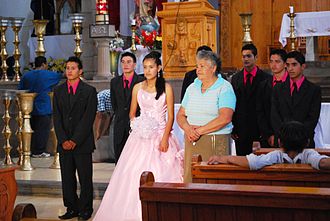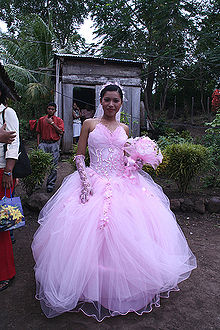Quinceanera
As a quinceañera (short for Fiesta de quinceañera ), the 15th birthday of girls in some areas of Latin America is celebrated completely differently than all their other birthdays. The word quinceañera means “fifteen year old”.
The party
The celebration honors the 15-year-old's transition from child to woman . It serves to recognize that the girl in question has reached maturity. The celebration varies a lot depending on the country. In the Dominican Republic, for example, the festival is centered on the debutant ball.
Argentina, Paraguay and Uruguay
In Argentina , Paraguay and Uruguay , the celebration begins with the arrival of the 15-year-olds, usually on their father's arm and accompanied by music, with a special entrance through the front door where friends or relatives present flowers (usually pink). Then the ceremony begins with a waltz . During the celebration, the girl dances with all her friends and male relatives.
Usually the ball is divided into different sections in the process, between which the meal courses are served.
The process is usually:
- The arrival, which is usually accompanied by slow songs
- The Waltz
- The appetizer
- First dance sequence
- The main course
- Second dance sequence
- dessert
- The 15 candles ceremony (optional)
- Third dance sequence
- The toast, the cake cutting, the bows
- " Carnaval Carioca " (Optional: Can also be a " Batucada " (type of music / rhythm))
- End the celebration with breakfast or pizza with beer
The ceremony of 15 candles: During this ceremony, the birthday child hands over 15 candles to the people who were most important to them in the development of their 15 years. The handover is usually accompanied by a speech dedicated to the people who will receive this award.
Mexico
In the Mexican tradition, if the 15-year-old is Catholic , the festival begins with a thank-you mass , to which the 15-year-old attends in a festive dress (usually it will be pink, blue or green. Lately, since the year 2000, there are different models, printed and some with cleavage). This is often similar to a wedding dress, but never white. She is accompanied by her parents, godparents , seven ladies of honor and seven "lords of honor " (the "chambelanes"). After the mass, sisters, cousins and friends give her the festive gifts and the "Quinceañera" lays her bouquet on the altar of the Blessed Virgin Mary . Originally, the mass was followed by a party at home at the "Quinceañera" or in the dining room of a banquet, pub or ballroom booked for this purpose. At the festival, the Quinceanera danced with their parents, relatives or friends, mostly with the "lords of honor" who were possible applicants. It was also customary for the ladies and gentlemen to dance a waltz. Nowadays, ladies of honor are no longer common and the number of "honorary lords" is a maximum of 4, rarely more. The majority of Mexicans celebrate the feast of the "15" with a lot of entertainment (relaxed and fun), where, unlike other countries, they dance to different rhythms. In contrast to other countries, it is often salsa , cumbia , merengue , pop , reggae , norteñas , cha cha cha , mambo , rock 'n' roll , or according to current rhythms such as B. To dance La Quebradita and Pasito Duranguense . In the villages of Mexico, the festivals usually last for many days and there is plenty of food. The typical drinks are tequila , mezcal , pulque (agave must), tequila is preferred in the cities. Beer is consumed both in the city and in the country. Even if the drunkenness has already started, the body continues to drink and dance to the limit of suffering.
At the majority of the “quinceañera” festivals, if the budget allows, the mariachis (Mexican folk musicians) add a certain spice with their rhythms. A classic song is "el mariachi loco" (the crazy mariachi).
This type of party is usually captured on video in order to see him at home and to relive the emotional moments.
Cuba
In Cuba the central ritual of the Quince is the dance of the "Quinceañera" around their mother. A group dance choreography can also take place in which 16 couples waltz around the “Quinceañera”, led by one of the main dancers (a boy of their choice or friend / fiancé). The choreography sometimes includes another 4 or 6 experienced dancers, called “companions”, who are allowed to dance the “quinceañera”. As a rule, these are inexperienced dancers, the task of which is to highlight the main couple. They are also allowed to wear different colored tuxedos.
The custom came to Cuba from Spain, but the greatest influence was French . The wealthy families who could afford to rent expensive halls in private clubs and hotels with 4 to 5 stars were the true forerunners of the "Quinceañera", which were called "Quinces". This ceremony usually took place in the girl's house or in some relative's more spacious house.
Even today, the quince is the most important event in the life of a Cuban woman, even more important than the wedding. The parents often save for years from the meager Cuban wage of around € 15 a month in order to offer the girl a party that can easily cost an average annual salary. The most important thing is the keepsake for later. The girl is spruced up and professionally made up and pretty, borrowed clothes are put on. A series of photos is then taken in an appropriate setting. Even after more than half a century of socialism and a life of poverty, girls dress up in bourgeois or aristocratic style.
Puerto Rico
In Puerto Rico a great celebration it holds, where wealthy families they hold the company in high-class hotels or clubs (poor families, however, in their homes and / or buildings or Village clubhouses). Also fraternities be used for this significant event.
The clothes of the young "Quinceañera" are white and long with inlays, embroidery (in rolls), not to be forgotten with a small flower crown, which is later replaced by a tiara . The party is celebrated, accompanied by your partner (can be the chosen boy, boyfriend or a related boy). Also included are the 14 couples (in general this should be many friends and / or relatives of the young honorees), who each individually represent the different "stages of the life" of the girl, starting with childhood (always represented by a single pair of children) demonstrate the change from flat to high-heeled shoe, which symbolizes the change from girl to woman (the father of the "Quinceañera" makes this change), and the honored girl dances with her father (songs like "My pretty girl" or "Vom Mädchen zur Frau ”(the latter is by the famous Spanish singer Julio Iglesias and is most often used for the dance of the quinceañera with the father)). The invited break off the dance, they say toasts, they eat, they drink and they dance. The music that you dance to at the festival is reggae, salsa, merengue and many other dances and rhythms. During the opening protocol of the celebration (parade, inspection, changing shoes from flat to high-heeled shoes, etc.) there is background music that is consistently gentle and instrumental.
The girl is putting together a souvenir album and a photo of her is usually put in the living room of the house. In addition, with the great technological advancement, photo presentations of the "Quinceañera" are created on video computer systems. These presentations by the girl will be shown at the celebration and will be part of the protocol.
The most played waltz in Puerto Rico is the "Tiempo de Vals" by the famous Puerto American singer Chayanne.
There is also queues of cars from the house of the young "Quinceañera" to the church (where a mass is held in honor of the young "Quinceañera" if she is Catholic, or a service or religious ceremony if the young "Quinceañera" belongs to another religion , such as e.g. Baptism , Pentecostal , Adventism etc.) and from the church to the reception of the celebration, with the honored person sitting in the foremost carriage of the queue with her partner (usually a very impressive one is used). Also limousines are often used, in which the young "Quinceañera" drive together with her partner and the couples performing. Around 2007 the “ Hummer ” model was very popular for this special event.
marketing
The Berliner Zeitung reported in late April 2009 on the constraints in many countries, securing millions of jobs and billions in sales: designers, singers, entertainers, DJs, decorators, chefs, caterers, photographers, pyrotechnics, etc. The newspaper reported a single mother from Rio de Janeiro, who earns 330 euros a month, but spends 1,380 euros on a small celebration. However, celebrations with several hundred guests are normal and can cost around 30,000 euros.
Processing of the topic in the film
The American film The 15th Birthday (original title: Quinceañera) deals in detail with the subject of Quinceañera and the meaning of the festival for a young girl and her family. The film has won several awards, including at the international Sundance Film Festival , where it received both the Grand Jury Prize and the Audience Prize. Likewise, in the film City of McFarland, a quinceanera is celebrated for the daughter of the protagonist.
literature
- Ilan Stavans (Ed.): Quinceaņera. ABC-CLIO 2010, ISBN 978-0-313-35824-1 .
- Claudia Mitchell, Jacqueline Reid-Walsh: Girl Culture: Studying Girl Culture - A Readers' Guide . ABC-CLIO 2008, ISBN 978-0-313-33909-7 , pp. 493-496 ( excerpt from Google book search)
- Heidi Härkönen: Girls' 15-Year Birthday Celebration as Cuban Women's Space Outside of the Revolutionary State (PDF; 690 kB). Journal of the Association of Social Anthropologists, July 2011
Individual evidence
- ↑ a b Cuba before the change. Island from another time. ZDF documentary by Christoph Röckerath. Germany 2011
- ↑ Tania Díaz Castro: Solamente las fotos , Cubanet of 23 August 2012
- ↑ Prinzessinnen-Nacht , Berliner Zeitung , April 26, 2009, p. 10.
- ↑ IMDb
- ↑ IMDb

